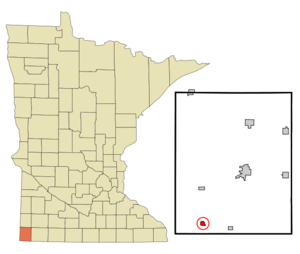- Hills, Minnesota
Infobox Settlement
official_name = Hills, Minnesota
settlement_type =City
nickname =
motto =
imagesize =
image_caption =
image_
imagesize =
image_caption =
image_
mapsize = 250px
map_caption = Location of Hills, Minnesota
mapsize1 =
map_caption1 =subdivision_type = Country
subdivision_name =United States
subdivision_type1 = State
subdivision_name1 =Minnesota
subdivision_type2 = County
subdivision_name2 = Rockgovernment_footnotes =
government_type =
leader_title =
leader_name =
leader_title1 =
leader_name1 =
established_title =
established_date =unit_pref = Imperial
area_footnotes =area_magnitude =
area_total_km2 = 1.3
area_land_km2 = 1.3
area_water_km2 = 0.0
area_total_sq_mi = 0.5
area_land_sq_mi = 0.5
area_water_sq_mi = 0.0population_as_of = 2000
population_footnotes =
population_total = 565
population_density_km2 = 448.1
population_density_sq_mi = 1160.7timezone = Central (CST)
utc_offset = -6
timezone_DST = CDT
utc_offset_DST = -5
elevation_footnotes =
elevation_m = 453
elevation_ft = 1486
latd = 43 |latm = 31 |lats = 35 |latNS = N
longd = 96 |longm = 21 |longs = 30 |longEW = Wpostal_code_type =
ZIP code
postal_code = 56138
area_code = 507
blank_name = FIPS code
blank_info = 27-29204GR|2
blank1_name = GNIS feature ID
blank1_info = 0644996GR|3
website =
footnotes =Hills is a city in Rock County,
Minnesota ,United States . Located approximately four miles (6 km) from theSouth Dakota border and two miles (3 km) from theIowa border, it is the southwestern-most city in Minnesota. The city was founded in 1890 at the junction of the Sioux City and Northern Railroad (which later merged into the Great Northern Railway) and the Cherokee and Sioux Falls Railroad (which later merged into theIllinois Central Railroad ). The city derives its name from the president of the Sioux City and Northern, Fredric C. Hills. Most of the businesses and residents moved from the nearby town of Bruce,Minnesota (2 miles west) when the Sioux City and Northern built north from Sioux City,Iowa to Garretson,South Dakota . The town of Bruce slowly faded away when the last buildings were removed in the early 1970s. Although the Illinois Central tracks were removed in 1982, theBNSF Railway (the successor to the Great Northern) continues to serve Hills to this day.The population was 565 at the 2000 census.
Geography
According to the
United States Census Bureau , the city has a total area of 0.5square mile s (1.3km² ), of which, 0.5 square miles (1.3 km²) of it is land and 2.00% is water. The landscape is flat with some gently rolling hills; however, the town's name does not derive from a particular topographical feature.Agriculture
The local economy is largely dependent upon agriculture; corn and soybeans are the region's primary cash crops.
Demographics
As of the
census GR|2 of 2000, there were 565 people, 230 households, and 149 families residing in the city. Thepopulation density was 1,160.7 people per square mile (445.2/km²). There were 244 housing units at an average density of 501.2/sq mi (192.3/km²). The racial makeup of the city was 99.29% White, 0.18% African American, 0.18% Asian, 0.18% Pacific Islander, and 0.18% from two or more races. Hispanic or Latino of any race were 0.35% of the population.There were 230 households out of which 27.0% had children under the age of 18 living with them, 55.2% were married couples living together, 7.4% had a female householder with no husband present, and 34.8% were non-families. 33.0% of all households were made up of individuals and 19.6% had someone living alone who was 65 years of age or older. The average household size was 2.23 and the average family size was 2.81.
In the city the population was spread out with 20.5% under the age of 18, 6.7% from 18 to 24, 22.1% from 25 to 44, 21.8% from 45 to 64, and 28.8% who were 65 years of age or older. The median age was 46 years. For every 100 females there were 87.7 males. For every 100 females age 18 and over, there were 82.5 males.
The median income for a household in the city was $33,125, and the median income for a family was $43,750. Males had a median income of $30,000 versus $21,833 for females. The
per capita income for the city was $15,824. About 2.8% of families and 5.6% of the population were below thepoverty line , including 3.1% of those under age 18 and 11.6% of those age 65 or over.Education
The Hills school system consolidated with the Beaver Creek school system in the 1960s, when it became Hills-Beaver Creek (H-BC). The high school, which houses grades 7-12, is located in Hills; the elementary school, with grades K-6, is located in Beaver Creek. There were 294 students enrolled in grades K-12 in 2005.
References
Wikimedia Foundation. 2010.


